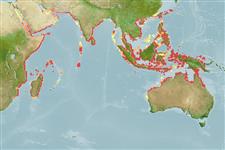Environment: milieu / climate zone / depth range / distribution range
Écologie
marin; saumâtre démersal; non migrateur; profondeur 0 - 5 m (Ref. 6205). Tropical; 27°N - 30°S, 33°E - 148°E (Ref. 6205)
Indo-Pacific: South Africa, northward to Pakistan, India, Myanmar, Indonesia, northern New Guinea, Thailand, Philippines, and Taiwan. Not recorded from southern New Guinea or Australia.
Taille / Poids / Âge
Maturity: Lm ? range ? - ? cm
Max length : 35.0 cm SL mâle / non sexé; (Ref. 6205)
Épines dorsales (Total): 12 - 13; Rayons mous dorsaux (Total): 20-21; Épines anales 2; Rayons mous anaux: 22 - 23; Vertèbres: 35. The first ray of the pelvic fin is modified into a laterally compressed thickened club-like structure. The swim bladder is reduced in size. There is no duct-like process from the ventral surface to the urogenital aperture.
Inhabit shallow coastal waters (Ref. 6205). Oviparous (Ref. 205). Marketed fresh (Ref. 6205).
Life cycle and mating behavior
Maturité | Reproduction | Frai | Œufs | Fécondité | Larves
McKay, R.J., 1992. FAO Species Catalogue. Vol. 14. Sillaginid fishes of the world (family Sillaginidae). An annotated and illustrated catalogue of the sillago, smelt or Indo-Pacific whiting species known to date. Rome: FAO. FAO Fish. Synop. 125(14):87p. (Ref. 6205)
Statut dans la liste rouge de l'IUCN (Ref. 130435)
Menace pour l'homme
Harmless
Utilisations par l'homme
Pêcheries: commercial
Plus d'informations
Noms communsSynonymesMétabolismePrédateursÉcotoxicologieReproductionMaturitéFraiRassemblement de ponteFéconditéŒufsDéveloppement de l'œuf
RéférencesAquacultureProfil d'aquacultureSouchesGénétiqueElectrophoresesHéritabilitéPathologiesTraitementNutrientsMass conversion
CollaborateursImagesStamps, Coins Misc.SonsCiguateraVitesseType de nageSurface branchialeOtolithesCerveauxVision
Outils
Articles particuliers
Télécharger en XML
Sources Internet
Estimates based on models
Preferred temperature (Ref.
123201): 27.5 - 29.3, mean 28.7 °C (based on 1629 cells).
Phylogenetic diversity index (Ref.
82804): PD
50 = 1.0000 [Uniqueness, from 0.5 = low to 2.0 = high].
Bayesian length-weight: a=0.00661 (0.00379 - 0.01151), b=3.08 (2.92 - 3.24), in cm total length, based on LWR estimates for this species & (Sub)family-body (Ref.
93245).
Niveau trophique (Ref.
69278): 3.3 ±0.5 se; based on size and trophs of closest relatives
Résilience (Ref.
120179): Milieu, temps minimum de doublement de population : 1,4 à 4,4 années (Preliminary K or Fecundity.).
Fishing Vulnerability (Ref.
59153): Low to moderate vulnerability (33 of 100).
